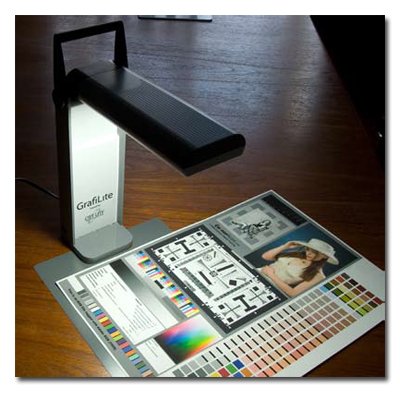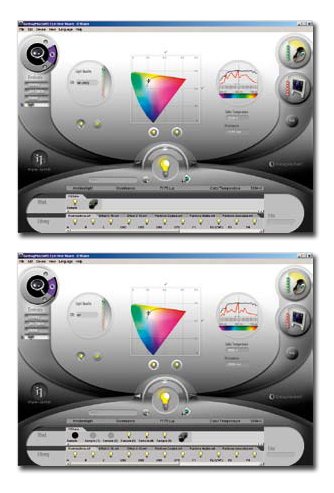articles/Review/grafilite-page1
Grafilite for peace of mind when viewing - part 1 of 1
by Mike McNamee Published 01/04/2008

The Grafilite creates a pool of even light, big enough for a 10x8 print, but does not cover an A3+
The simple ideas are the best! Critical viewing of prints should always be carried out in good light, of known quality. Nothing is purer than sunlight but it has the problem of being variable and sometimes not present at all, for example in an enclosed room. Standard high-end graphics practice is to use an enclosed, grey booth, illuminated with lights of known quality and strength. For occasional, or less serious users, such booths are expensive and very bulky.
The Grafilite cuts through these issues by providing a light of reasonable quality in a highly portable package, which packs away when not required. While it is not suitable for critically reviewing a B2 press sheet, it can easily accommodate a 16x20 inch print. It is sufficiently portable for you to take it along when you show commercial clients their proofs or results.
Light Quality
The illuminant is not accurately specified in any of the literature that accompanies the product, the preference being to endorse the product with the name of the bulb inventor Dr John Ott. This carries little weight with your sceptical editor and so we set up to measure the light quality.
There are three main parameters to consider:
1. The quality of the light spectrum (as measured by the Colour Rendering Index)
2. The Colour Temperature (in degrees Kelvin (°K), normally 5,000°K or 6,500°K for print reviewing)
3. The illumination level (measured in lux at the print surface)
A more qualitative measure may be judged by using the GATF/RHEM light indicator. This device shows stripes when the light is not the so-called D50, the standard for the graphics industry. The Grafilite passed this test

The spectral data of the Grafilite delivers a lower CRI than a graphics grade tube. The slightly more 'spikey' trace (in red) on the lower screen grab (Grafilite) is the tell-tale evidence
Although the Grafilite is a mere 14 watts (which keeps everything very cool), it generates 2,000lux at the print surface, complying with both ISO 3664 and ISO 12646 both of which specify between 1,500 and 2,500 lux at D50. The spread of light is relatively even for a whole 10x8 inch print (or a larger one with a bit of imagination).
The Colour Rendering Index (CRI) is a measure of how closely the spectral output of the illuminating light matches that of the standard. For compliance with ISO 3664 the CRI should be at least 90 (perfection is 100). The Grafilite returned a value of between 83 and 87 as it warmed up. Warm-up to stability took a couple of minutes. The colour temperature was measured at 5,580°K. For comparison the Professional Imagemaker viewing booth returned values of CRI 95 and a temperature of 5,329°K. This booth uses graphics specification tubes.
Who needs a Grafilite?
The unit will be a boon to anybody who has to view either images or products in reasonably accurate, standardised light. It is way ahead of most low-energy bulbs, if a little behind a good viewing booth. Anybody who needs to show prints to clients under known conditions will also benefit, eg those making art reproductions. Medical photographers and scientific photographers would also find the unit useful. The only other option apart from a viewing booth is to flood the work area with graphics tubes throughout. This is the solution used in say the press industry, but in a more domestic environment the light is rather cool and clinical. At £60 you can afford to have a Grafilite in the cupboard to give you peace of mind when reviewing your work.
See www.colourconfidence.com
The Grafilite £51.06
Spare Bulb £12.77
GATF/REHM indicators £30.00 (50 off )
All prices ex VAT
You are currently on page 1 Contact Mike McNamee
1st Published 01/04/2008
last update 09/12/2022 14:54:49
More Review Articles
There are 22 days to get ready for The Society of Photographers Convention and Trade Show at The Novotel London West, Hammersmith ...
which starts on Wednesday 14th January 2026





